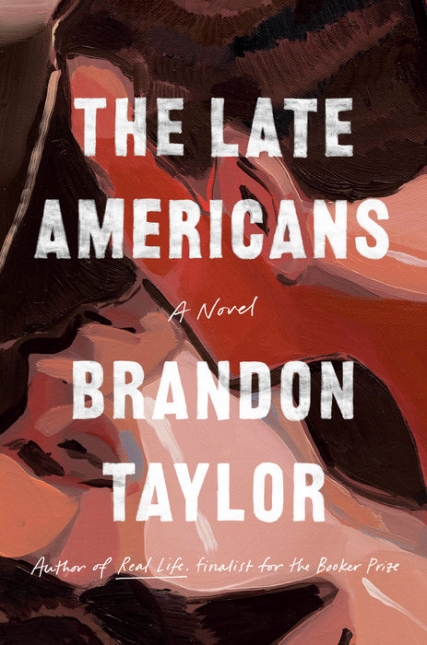The Late Americans: A Novel
- By Brandon Taylor
- Riverhead Books
- 320 pp.
- Reviewed by Ellwood Johnson
- June 6, 2023
Twentysomethings try to make sense of the world and their place in it.

In The Late Americans, Brandon Taylor’s new campus novel about art, aspiration, and desire, a group of self-assured college students are forced to reconsider their choices in the face of precarity. With the publication of his debut novel, Real Life, in 2020, and a story collection, Filthy Animals, in 2021, Taylor has proven his gift for peeling back the layers of the commonplace to reveal the extraordinary. In that same vein, The Late Americans is a virtuosic performance of social and psychological realism fraught with the anxieties of our current post-postmodern moment.
The novel follows a loose circle of undergrads trying to carve out an existence in the assorted public and private spaces of Iowa City. These would-be writers, painters, musicians, and the occasional financier must find a way to come to terms with their pasts, navigate their presents, and forge their futures in a world increasingly separated along cultural, political, and economic lines.
The book is divided into nine chapters, each one alluding to a particular artistic, philosophical, religious, historical, or economic concept that provides a framework for understanding the various motives underpinning the characters’ seemingly transactional relationships.
These characters include Seamus (an aspiring poet with sadomasochistic tendencies), Noah (a half-Japanese, half-white wannabe dancer), and two couples: Fyodor and Timo, whose sex life is motivated by unresolved tensions, and Ivan (the odd MBA student among aesthetes who dabbles in porn) and Goran (a Black guy adopted by a wealthy white family), whose relationship comically dramatizes interracial and interclass tensions.
One of Taylor’s strengths lies in his ability to imbue ordinary social interactions with an elevated degree of emotional intensity. Some of the novel’s most poignant scenes are the ones in which he holds a mirror to our contemporary attitudes and behaviors. For instance, when Seamus, a first-year student in an MFA program, deigns to write about the profane life of man and the sacred life of God and the Holy Spirit — rather than grandly expound on the nature and function of literary endeavors in the 21st century — his work is criticized by a classmate for its lack of political heft:
“‘To me,’ someone interjected, ‘the biggest issue here is that the author has substituted formal stricture for emotional rigor and seems unwilling to engage with the political dimension such a choice entails.’”
Aspiring writers like Seamus are forced to choose between creating art for art’s sake and falling in line with the prevailing (in some circles) ethos that all art must be political. The author, for his part, refrains from urging readers in one direction or another. Rather, he sketches these modern-day cultural dilemmas with finesse, asking readers to judge for themselves.
The book’s third-person narration and large cast give it both a symphonic and discordant quality that calls to mind George Eliot’s Middlemarch, a work of high-Victorian realism whose multiple plotlines and proliferating characters produce the narrative equivalent of surround-sound. The result is a surreality akin to the sensation experienced by Seamus as he makes his way home across a windy and luminous landscape:
“It was like living in a museum exhibit or a dollhouse. It was so easy to imagine the hands of some enormous and indifferent God prying the house open and squinting at them as they went about their lives on their circuits like little automations in an exhibit called The Late Americans. A God with a Gorgon’s head peering down in judgment.”
Taylor’s novel is a work of art that concerns itself with works of art, and with what the German philosopher Martin Heidegger referred to as the work of art: the way in which it is not only a means of expressing truth but also of creating truth. By the end, the characters (as well as readers) have been exposed to multiple artistic pieces and are left to ponder the relationship between truth, art, and the mundane trivialities of everyday life. One might ask, “Are we too late in history for such questions to matter?” Taylor suggests that the answer is both complicated and simple.
Ellwood Johnson is a freelance writer and editor and full-time teacher in Baltimore, MD. He is the incoming English Department chair at the St. Paul’s School for Girls in Brooklandville, MD. His reading and teaching interests include 19th-century British literature and contemporary global anglophone literature.

